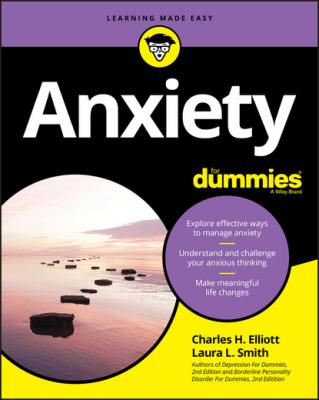ТОП просматриваемых книг сайта:
Anxiety For Dummies. Laura L. Smith
Читать онлайн.Название Anxiety For Dummies
Год выпуска 0
isbn 9781119768531
Автор произведения Laura L. Smith
Издательство John Wiley & Sons Limited
Accelerated heartbeat
Shallow, rapid breathing
A spike in blood pressure
Dizziness
Fatigue
Gastrointestinal upset
General aches and pains
Muscle tension or spasms
Sweating
NAME THAT PHOBIA!
Phobias are one of the most common types of anxiety, and we discuss them in detail in Chapter 2. A phobia is an excessive, disproportionate fear of a relatively harmless situation or thing. Sometimes, the object of the phobia poses some risk, but the person’s reaction clearly exceeds the danger. Do you know the technical names for phobias? Draw arrows from the common name of each phobia to the corresponding technical name. See how many you get right. The answers are printed upside down at the bottom.
Be careful if you have triskaidekaphobia (fear of the number 13), because we’re giving you 13 phobias to match!
| Technical Name | Means a Fear of This |
|---|---|
| 1. Ophidiophobia | A. Growing old |
| 2. Zoophobia | B. Sleep |
| 3. Gerascophobia | C. The mind |
| 4. Acrophobia | D. Imperfection |
| 5. Lachanophobia | E. Snakes |
| 6. Hypnophobia | F. Fear |
| 7. Atealophobia | G. New things |
| 8. Phobophobia | H. Animals |
| 9. Sesquipedalophobia | I. Small things |
| 10. Neophobia | J. Mirrors |
| 11. Psychophobia | K. Heights |
| 12. Microphobia | L. Long words |
| 13. Eisoptrophobia | M. Vegetables |
Answers: 1. E, 2. H, 3. A, 4. K, 5. M, 6. B, 7. D, 8. F, 9. L, 10. G, 11. C, 12. I, 13. J
Seeking Help for Your Anxiety
As we say earlier in this chapter, most people simply choose to live with anxiety rather than seek professional help. Some people worry that treatment won’t work. Or they believe that the only effective treatment out there is medication, and they fear the possibility of side effects. Others fret about the costs of getting help. And still others have concerns that tackling their anxiety would cause their fears to increase so much that they wouldn’t be able to stand it.
Matching symptoms and therapies
Anxiety symptoms appear in three different spheres, as follows (see the earlier section “Recognizing the Symptoms of Anxiety” for more details on these symptoms):
Thinking symptoms: The thoughts that run through your mind
Behaving symptoms: The things you do in response to anxiety
Feeling symptoms: How your body reacts to anxiety
Treatment corresponds to each of these three areas, as we discuss in the following three sections.
Thinking therapies
One of the most effective treatments for a wide range of emotional problems, known as cognitive therapy, deals with the way you think about, perceive, and interpret everything that’s important to you, including
Your views about yourself
The events that happen to you in life
Your future
Luann, a junior in college, gets physically ill before every exam. She throws up, has diarrhea, and her heart races. She fantasizes that she will fail each and every test she takes and that eventually, the college will dismiss her. Yet, her lowest grade to date has been a B–.
The cognitive approach her therapist uses helps her capture the negative predictions and catastrophic outcomes that run through her mind. It then guides her to search for evidence about her true performance and a more realistic appraisal of the chances of her actually failing.
As simple as this approach sounds, hundreds of studies have found that it works well to reduce anxiety. Part 2 of this book describes various cognitive or thinking therapy techniques.
Behaving therapies
Another highly effective type of therapy is known as behavior therapy. As the name suggests, this approach deals with actions you can take and behaviors you can incorporate to alleviate your anxiety. Some actions are fairly straightforward, like getting more exercise and sleep and managing your responsibilities. You can get good ideas on those actions in Chapter 11.
On the other hand, a more critical type of action targets anxiety directly. It’s called exposure and feels a little scary. Exposure involves breaking your fears down into small steps and facing them one at a time. We cover exposure in Скачать книгу

